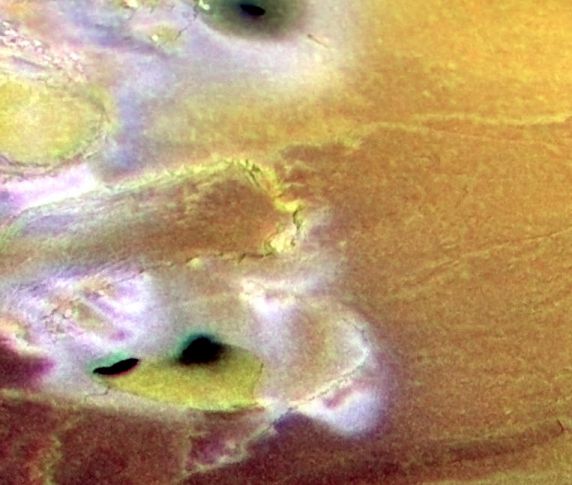Explanation: Braving intense radiation belts, the Galileo spacecraft once again flew past the surface of Jupiter's moon Io (sounds like EYE-oh) on February 22. Combining high resolution black and white images from that flyby with color data recorded last summer has resulted in this dramatic view of a region near the volcanic moon's south pole. An active and alien landscape, the bright white areas are likely due to sulfur dioxide frost and seem to be concentrated near ridges and cliffs. The three ominous black spots, each about 6-12 miles across, are volcanic craters or calderas covered with recent dark lava. A sinuous channel connects the lower left caldera with a yellowish lava flow. Io is small, but its continuous activity is driven by the drastic tides induced by Jupiter and the other Jovian moons. It is estimated that the resulting volcanism completely resurfaces Io every million years.
1999 2000 2001 2002 2003 2004 2005 2006 2007 2008 2009 2010 2011 2012 2013 2014 2015 2016 2017 2018 2019 2020 2021 2022 2023 2024 2025 |
Yanvar' Fevral' Mart Aprel' Mai Iyun' Iyul' Avgust Sentyabr' Oktyabr' Noyabr' Dekabr' |
NASA Web Site Statements, Warnings, and Disclaimers
NASA Official: Jay Norris. Specific rights apply.
A service of: LHEA at NASA / GSFC
& Michigan Tech. U.
|
Publikacii s klyuchevymi slovami:
Io - south pole - caldera - volcano - Io - vulkan - galileevy sputniki
Publikacii so slovami: Io - south pole - caldera - volcano - Io - vulkan - galileevy sputniki | |
Sm. takzhe:
Vse publikacii na tu zhe temu >> | |
